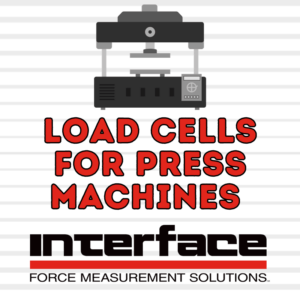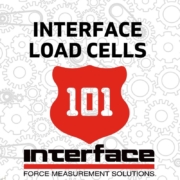Interface Load Cells for Press Machines
 Press machines are designed to measure and apply force for various reasons. Hydraulic presses can be used to shape materials or crush objects. Stamping presses make a visible impression or stamp onto materials, such as a pharmaceutical tablet or logo on a food product. Even sandwich presses follow many of the characteristics of more industrial presses.
Press machines are designed to measure and apply force for various reasons. Hydraulic presses can be used to shape materials or crush objects. Stamping presses make a visible impression or stamp onto materials, such as a pharmaceutical tablet or logo on a food product. Even sandwich presses follow many of the characteristics of more industrial presses.
Press machines are used across automotive, aerospace, construction, consumer goods, medical, agriculture, mining, and other industries. The presses produce consistent, cost-effective quality parts, tools, and products. No matter what kind of press machine, it must undergo rigorous testing during the machine-building process. During operation, there must be continuous monitoring of the press force used in each application.
NEW! Interface Solutions for Machine Builders
Interface load cells are critical to designing, testing, and using accurate and reliable press machinery. Interface load cells come in various shapes, dimensions, and capacities, allowing press machine builders and engineers to find the best solution for their specific machinery use case. Whether selecting a miniature load button load cell for a small press test or our WMC Load Cell to integrate into the machine, Interface has a range of products for press machine applications.
Benefits of using load cells in press machines:
- Enhance Operator Safety
- Prevention of Overloading
- Improve Consistency
- Avoid Damage to Equipment
- Reduce Waste and Scrap
- Increase Quality and Consistency of Work Product
- Improve Process Control
- Extend the Life of the Machine’s Operation
- Increase Productivity
In a press machine test, the load cell is typically placed between the ram of the press and the die, where it can measure the force being applied to the object. The load cell is usually connected to a readout or display showing the operator the force applied to the part or material. This readout may be a simple analog or digital display, depending on the specific press and load cell being used in the machine. Review our Instrumentation Selection Guide to find the best option for your press.
There are numerous options for the types of load cells used for press machine applications. Hydraulic presses are some of the most common presses that use load cells. These machines are often built to form metal parts, such as gears, shafts, and bearings. The construction industry uses presses to assemble and test concrete structures. These presses are designed to crush and process minerals and ore in mining.
Mechanical presses are typically used for high-precision applications, such as metal stamping and forming. Miniature load cells are used in more precise applications that require smaller measurements. These use cases are often reserved for the medical or consumer goods industry, where the goal is to provide a stamping force for medicine or candy to label the product without crushing or damaging it. A precision Interface load cell ensures that the force applied to the material is consistent and accurate.
Another type of press using a sensor is known as a screw press which forms and compacts materials such as plastic and rubber. These press machines are found in chemical, food, and waste processing facilities.
Depending on the measurement capacity needed in the machine’s application, two popular Interface options are the Rod End Load Cells and Mini WMC Sealed Stainless Steel Load Cells. A rod end load cell is typically installed at the end of the piston or ram, where it can measure the tension or compression force being applied during the pressing operation. These load cells provide accurate and reliable force measurement in various presses.
Press Forming and Load Monitoring
Press forming is a method to deform different materials. For instance, materials such as steel can be bent, stretched, or formed into shapes. A force measurement solution is required to monitor the forces being applied by the press-forming machine. This ensures quality control and traceability during the production process. Interface recommended installing the 1000 High Capacity Fatigue-Rated LowProfile™ Load Cell for large press forming machines. When the material is placed under the punch plate to form a shape, the 1000 series load cell measures the force applied. The captured force results were sent to the INF-USB3 Universal Serial Bus Single Channel PC Interface Module, where results could be graphed and logged on the customer’s PC using the provided software. Interface’s force measurement products and instrumentation accurately monitored and logged the force results of the press force machine, ensuring zero-error production performance.
Tablet Forming Machine Optimization
A pharmaceutical tablet producer wanted to monitor the forces the tablet forming machine applied to understand the relationship between raw material, die set, form, force, and the motor’s cycle speed. The goal was to improve the productivity and efficiency of the tablet-forming process while reducing losses (i.e., cracked tablets or voids) by adding a dimension of feedback that could be used to assign specific press adjustment criteria for given inputs. An Interface Model WMC Sealed Stainless Steel Mini Load Cell (10K lbf Capacity) was mounted in the section of the downward press bar. The machine was modified to accomplish this. The load cell was then connected to a Model 9320 Portable Load Cell Indicator to collect the needed data. After analyzing the data, the tablet producer could quantify adjustment levels by monitoring which forces produced optimal results for a given cycle speed, die set, and raw material. The enhancement of the data feedback significantly improves productivity and efficiency.
Candy Stamp Force Testing
Manufacturers of hard-shell candies often stamp text or logos on the candy shells. Stamping too hard breaks the candy shell and stamping too light results in an uneven or incomplete imprint. Using a test apparatus with an Interface Model WMC Mini Load Cell attached to hydraulic actuators was discovered to be an accurate way to measure the compression force required. Engineers determined the specific force needed to properly apply the imprint without breaking the candy shell using this solution.
Using Interface load cells on a press machine is a valuable investment that can help to improve the quality of the products being produced, extend the life of the press machine, and reduce the risk of accidents.
ADDITIONAL RESOURCES
Press Forming and Load Monitoring
Press Load Monitoring App Note
Hydraulic Press Machines and Load Cells
Interface Solutions for Machine Builders
Force Measurement Sensors are Essential to Modern Industrial Machinery








